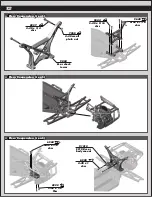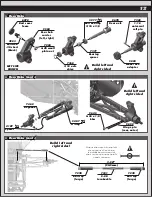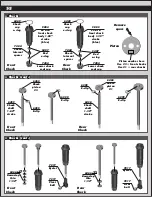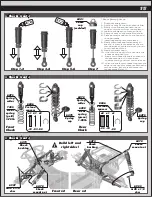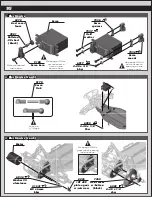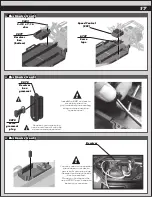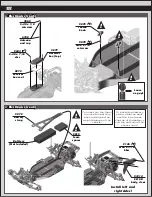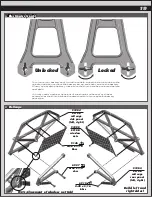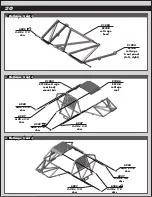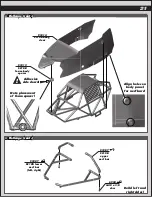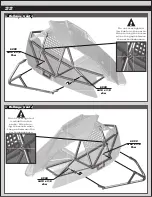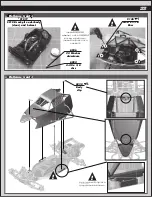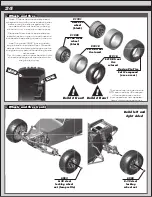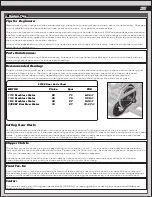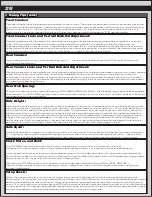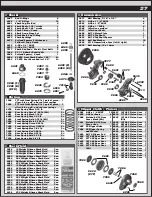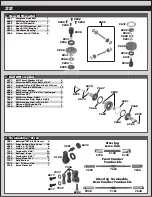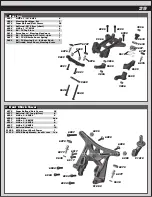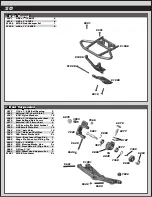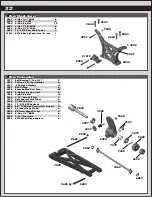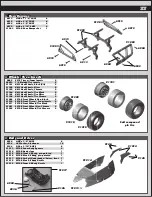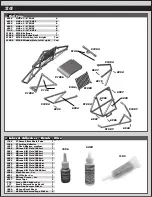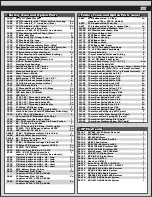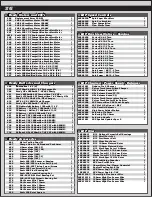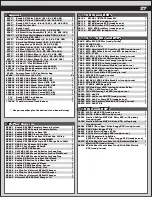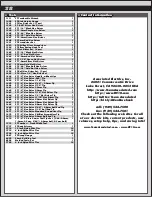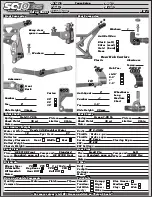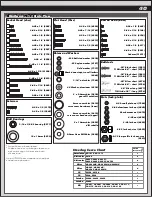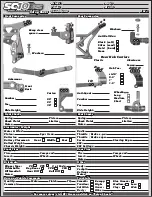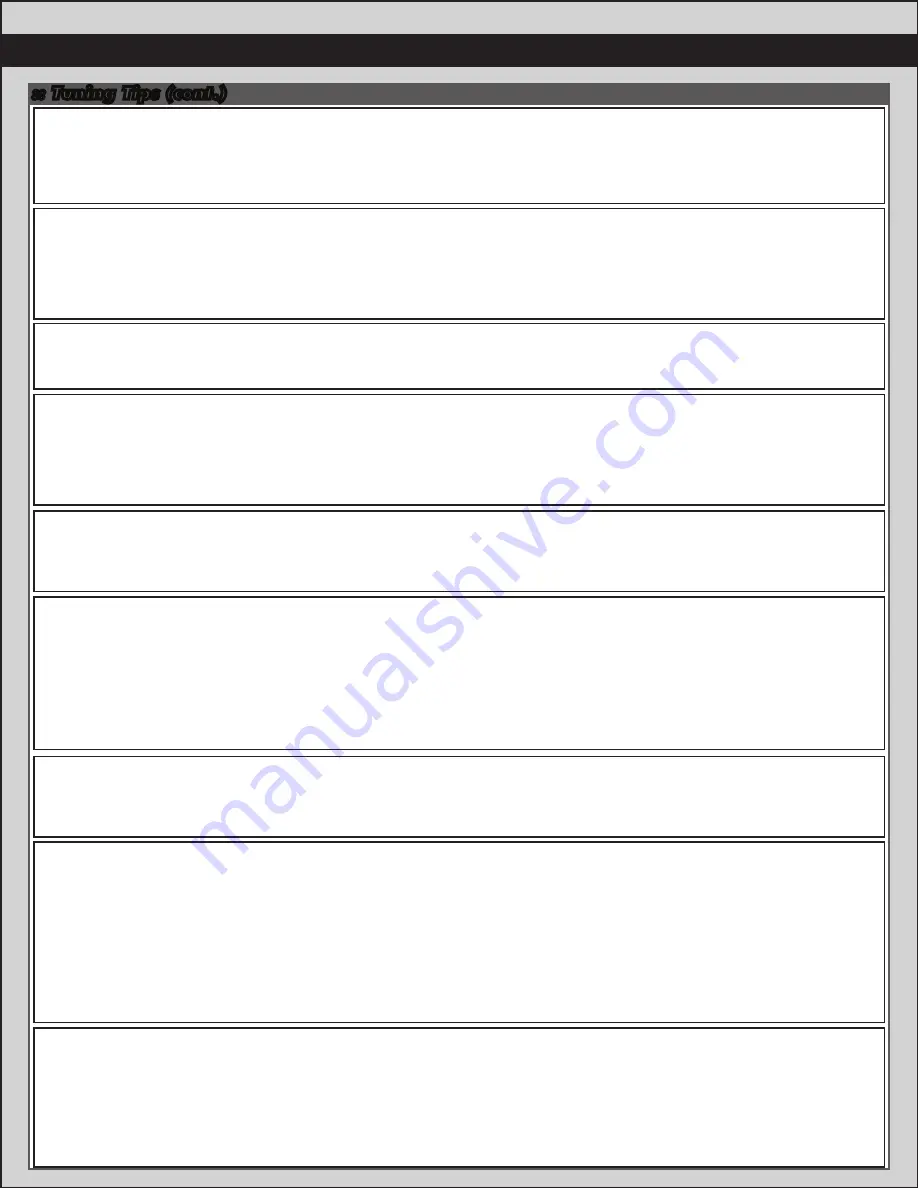
:: Tuning Tips (cont.)
Shock Piston and Fluid:
The SC10B’s shocks are built with our 2 hole, #1 pistons in the front and our #3 pistons in the rear.
All pistons have a number molded on them (use a black marker to color in the numbers for easy identification).
As a rule of thumb, larger hole pistons decrease damping which can help the vehicle in bumpy and low-grip situations.
On smoother tracks, or for large jumps, you may want to use a smaller hole piston which will increase damping and take
away some grip. [#1 large hole, #2 medium hole, #3 small hole]
Typically, your SC10B shocks will work best with shock fluid rates between 25 and 35 wt (275 - 425 CST).
Use the thicker weight fluids when changing to larger hole pistons. Use the thinner weight fluids when changing to
smaller hole pistons.
Rear Hub Spacing:
There are three options for rear hub spacing, FORWARD, MIDDLE, & BACK. The kit setting provides the best possible
rear traction. The FORWARD position will provide more rear traction for low grip tracks. The BACK position will provide
more steering on high grip tracks.
Ride Height:
Ride height is the distance from the bottom of the chassis to the ground. The standard front ride height setting is with
the inner and outer hinge pins of the front arms level on the same imaginary horizontal line, or 31mm as measured from
the bottom of the chassis directly behind the skid plate. The standard rear ride height setting is with the driveshafts
slightly below level i.e., the diff outdrives are slightly lower than the axles giving the driveshafts a small angle relative to
the ground. More specifically, the standard rear ride height is 29mm measured to the bottom of the gearbox where
it sticks through the rear chassis plate. To check ride height, lift up the entire car about 8-12 inches off the bench
and drop it level. After the suspension “settles” into place, add or remove pre-load clips until the desired ride height is
achieved. For precise ride height measurements, use the Factory Team ride height gauge #1449.
Anti-Squat:
Anti-squat denotes the angle of the rear arms relative to the ground. The kit setting is 2 degrees and can be adjusted
to 1 degree by removing the included 2 degree shim below the rear arm mount and replacing it with a 1 degree shim.
Changing to less anti-squat tends to make the truck produce more rear traction and less steering in the corners.
26
Setup Sheets:
Often, the best way to get your car handling right is to use one of the setups from our website as a starting point.
Go to www.rc10.com and click on the links to Setup Sheets, then SC10B setups. Our team of professional drivers helps
develop these setups at National events. Most drivers have a “base” setup that they use as a starting point for every
event. Try running some of our base setups OR look for track conditions and tires that are similar to your local track and
mimic that setup. Remember, each adjustment has a purpose, so copy everything from the setup sheet and then make
adjustments based on the recommendations in here and in our online tuning guide.
Rear Camber:
A good starting point for the rear camber setting is -1°. In loose track conditions, going to 0° camber can improve
straight-line acceleration.
Front Camber Links and Vertical Ballstud Adjustment:
Changing the length of the camber link is considered a bigger change than adjusting the ballstud height on the shock
tower. Shortening the camber link (or lowering the ballstud) will give the front end less roll and quicken steering
response, especially on corner entry. Lengthening the camber link (or raising the ballstud) will give the front end more
roll and slower steering response, but can produce more corner exit steering. Longer camber links are typically used
on high grip tracks and shorter links tend to work better on medium grip and loose tracks.
Rear Camber Links and Vertical Ballstud Adjustment:
Changing the length of the camber link is considered a bigger step than adjusting the ballstud height on the rear chassis
brace. Shortening the camber link (or lowering the ballstud) will give the rear end less roll and the car will tend to
accelerate or “square up” better. Lengthening the camber link (or raising the ballstud) will give the rear more roll and
more cornering grip. Longer camber links are typically used on high grip tracks, while shorter links tend to work better
on medium grip and loose tracks.
Front Camber:
Camber is the angle of the wheel when looked at from the front. The angle is measured from a line perpendicular to the
ground to the face of the wheel. Camber is used to ensure a wider tire contact patch while cornering. A good starting
point for the front is -1°. Performance will begin to decrease after -3°. Positive camber, where the top of the tire is
leaning out, is not recommended in the front. To set your camber use the included #1719 camber gauge.
Summary of Contents for SC10B RS RTR
Page 1: ...10 12 ...

